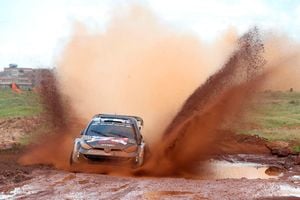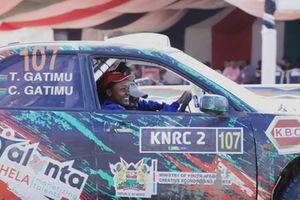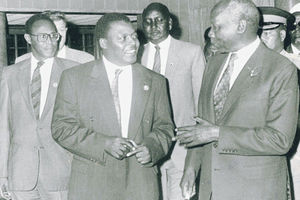
Kalle Rovanpera and his navigator Jonne Halttunen in a Toyota Yaris compete in the Kasarani Super special stage of the 2024 WRC Safari Rally on March 28, 2024. Inset: Safari Rally CEO Charles Gacheru.
Now is his second year as the WRC Safari Rally CEO, Charles Gacheru is confident of the future of this iconic motorcar race steeped in fabled adventures.
He spoke to Nation.Africa about preparation for this year’s rally, the challenges and progress made, new tweaks that will give spectators a closer encounter with the racing machines, efforts to commercialise the event, his favourite drivers and much more.
Question: Last year the WRC Safari Rally reverted to its traditional, Easter weekend dates to much enthusiasm from fans. Why was that decision made and will the same dates apply this year?
Answer: No. The 2025 WRC Safari Rally will be staged from March 20 to 23 in Nairobi County and Nakuru County. As you are aware, the Safari Rally is part of a global calendar of events and the move away from Easter was largely informed by that global calendar.
Easter weekend dates change from year to year and that movement would be disruptive to the global calendar.(This year’s Easter weekend is April 18-20).
Q: FIA recently published the WRC Safari Rally Supplementary Regulations. What does this signify?
A: The Supplementary Regulations make public the list of FIA officials, Safari Rally senior officials, the rally itinerary - down to the competitive and liaison distances. That document details how many entries will be allowed and in which classes, what the entry fee is and where to pay.
It contains all the important contact details and the various deadlines for ordering fuel and tyres among other services. It contains crucial information on insurance, shipping, scrutineering, service park and many other elements around the rally. The Supplementary Regulations are the Safari Rally's playbook. Publishing the Supplementary Regulations basically signals that the rally is truly on!
Q: Some quarters in the Kenyan rallying fraternity have accused WRC Safari Rally-Kenya of usurping the role of KMSF in as far as the process of acquiring the Visa for the 2025 WRC Safari Rally is concerned. What is your comment?
A: The WRC Safari Rally Project is a fully funded Government of Kenya project domiciled under the Ministry of Youth Affairs, Creative Economy and Sports. The Project is mandated to run the Safari Rally via an agreement reached between the Government of Kenya and the Kenya Motorsport Federation.
The Project's one agenda is to run the Safari Rally and among those functions, as indicated in the Kenya Gazette, is to coordinate with the WRC Promoter and the FIA in executing that mandate. Further, the Project reports to a Project Oversight Team headed by the Cabinet Secretary and among the members of that oversight team is the chairman of the KMSF. The Project adheres to the FIA regulations and in particular the 2025 FIA International Sporting Code and the 2025 FIA WRC Sporting Regulations.
The National Sporting Authority (ASN) has a pivotal role in the Safari Rally. For example, all the officials, volunteers and marshals we work with are all from the motorsport fraternity, people active within the federation and sport. Further, the local federation is responsible for the issuance of competitor licences and they also issue the ASN licence for the Safari Rally and any other rally in our country. The interaction between the Safari Rally Project, the ASN and the FIA is clearly defined in the Regulations and in the Government of Kenya and ASN contract -- and we follow those to the letter.
Q: How is your relationship with the KMSF? Would you say it is cordial and constructive?
A: The Project works closely with the KMSF General Manager and with the Directors of KMSF. Having said that, I think it is important to point out that the motorsport fraternity in Kenya includes 1,000s of drivers, co-drivers, marshals, officials, medics, media, time keepers, stage commanders and so on. We are working with the motorsport fraternity.
The Safari Rally cannot be staged without these motorsport enthusiasts. The federation is not four or five people, it is 1,000s of Kenyans who love the sport, who volunteer their time not just for the Safari Rally but also for karting, tarmac racing, hill climbing and many other sporting disciplines. I don't want to comment on the current wrangles at the KMSF that are playing out publicly. Our role at the Safari Rally is ring-fenced by the Government of Kenya from that chaos.
Q: How are the preparations for this year’s Safari Rally so far? What has been done and what more needs to be done to ensure you are ready to host this iconic rally?
A: We are ready. In fact, we have been ready for the rally for a few months now. We have identified the routes, we have introduced new stages, we have moved the Shakedown and created a new exciting Rally Village for the spectators. We are now focused on ensuring the local, regional and global crews put in their entries, travel to magical Kenya and compete.

Safari Rally CEO Charles Gacheru makes a point during NTV's SportOn! show on March 25, 2024.
We are also focused on publicity -- getting East Africans to know what the dates are and where you can safely watch the action. If I look at our work plan, there are many more documents that we need to submit to the FIA and to the WRC Promoter but we have no red flags, all deadlines are being met.
Q: How much would you need to stage a successful event?
A: That is not an easy question. There are the mandatory payments to the FIA and the WRC Promoter, those account for about 55 per cent of our budget. Then we have a huge human resource cost component, security and traffic management.
Safety is also costly. For instance, we are required, under the Regulations, to have air evacuation and we use nearly 70 ambulances. Running the Service Park for nearly three weeks is also costly from an infrastructure perspective.
Q: President Ruto last year talked about wanting the Safari Rally to eventually be funded through corporate sponsorship. How is that front looking at the moment?
A: There are two elements to commercialising the Safari Rally and making it more sustainable. The first is to be frugal -- cut the fat, drop the unnecessary frills. We have done that, that is why we were able to run the 2024 edition at nearly Sh1 billion less.
In 2025 we are reducing that even further. Secondly, getting more private money on board. In 2024, we attracted about Sh200m sponsorship from the private sector. In 2025, we are projecting to increase that by 50 per cent.
Q: Will there be any difference between last year’s rally and this year’s?
A: Yes, two. The first is a focus on spectators. We are determined to give all our spectators a great show. We are aiming to have 50 cars in the field, all the top WRC teams are coming to Kenya and our local heroes will also be in play. Further, we have set up a new Rally Village at Morendat Farm, about 4km away from the famous Delamare shops on the Naivasha-Nakuru Road.
We welcome all Kenyans and visitors to the Rally Village and not only catch the action live at a rally stage we have established there, but also enjoy the entertainment and food. The traditional spectator stages at Kedong, Soysambu and Hells Gate will remain. There is also another exciting spectator stage at Camp Moran, which will host the Shakedown on March 19 and a rally stage on March 21.
The second difference is on the competition itself; we have two new stages -- Camp Moran and Morendat, this will give both the competitors and spectators something new to look forward to. We are also running the following stages in reverse -- Kasarani SSS, Loldia, Elementaita and Soysambu.
Q: Do you ever see a Kenyan winning the WRC Safari Rally like it used to happen in the earlier years? Joginder Singh, Shekhar Mehta…
Yes! Having said that, to drive a WRC1 car, a Kenyan would have to be part of the works teams -- Toyota, Hyundai or M-Sport Ford. It is very much like F1, you can’t just go to a shop and buy a car and drive it very fast around Lake Naivasha. It doesn’t work like that, you have to be good enough to be invited to drive for one of the works teams.
Can a Kenyan drive for Toyota or Hyundai? Absolutely. There is talent in Kenya and in East Africa. It needs to be given the platform to succeed. That is what the local federation should be focusing on -- supporting local talent, drivers, competitions and so on. That is their mandate.
Q: What is the future of the WRC Safari Rally?
A: The WRC Safari Rally is the best rally on the WRC global circuit. It has the most viewership on WRC TV. Further, the Safari Rally has scored very highly in terms of safety and overall organisation of the rally. The future of the Safari Rally is bright. It can only get better.
Q: This is putting you on the spot, but which driver(s) do you admire most in the WRC and why?
A: Currently, my two favourite drivers are Karan Patel and Nikhil Sachania. I have travelled to Burundi and Rwanda to watch both in action in the ARC and you will not believe the popularity they have in those countries. Karan is a showman, he loves giving the crowd a thrill, he is the reigning Africa Rally Champion and with the necessary support, he can one day win the Safari Rally.
Nikhil's story is one of resilience. He controls his car using only his hands, having lost the ability to use his legs in a past accident. Nikhil will be driving a new car at the 2025 Safari Rally and I wish them both the best of luck.
Q: Finally, what would you tell a fan contemplating watching this year's Safari Rally?
A: For the first time, we will introduce a rally village within a stage. Welcome to Naivasha - and keep safety first. No picture, no view is worth losing limb or life over. Bring your friends and families. Don’t litter, don’t light fires in the conservancies. Be mindful of the environment. And please, be courteous on the roads.









